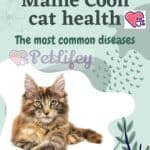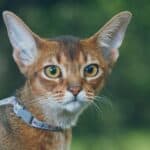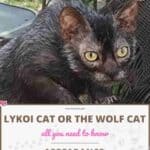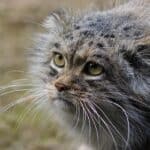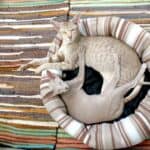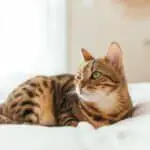What you need to know: from character to education to tips for apartment living
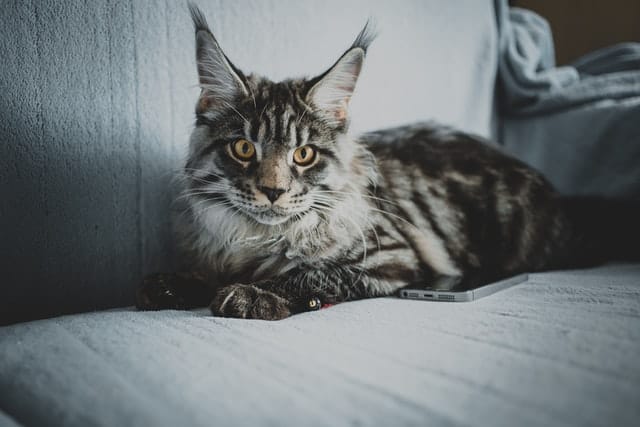
One of the most loved and characteristic cats is certainly the Maine Coon cat: it is an imposing-looking cat, but in reality it is a nice playful for the little ones. Let’s go and discover all its features.
Origin and history of the Maine Coon cat
The Maine Coon cat, from the name itself, is of North American origins, exactly from the cold region of Maine. The term “coon” actually means raccoon, because the tail of this cat is very reminiscent of that of a raccoon. In fact, many call it “raccoon cat“.
Coming from an area where winters are quite harsh, even its appearance and the conformation of the coat have adapted to protect the feline from the cold and give it the possibility to face even the coldest temperatures.
Numerous legends circulate about the origins of Maine Coon cats , so much so that it is difficult to trace its history.
In Italy this breed arrived very late, only in 1986, but since then it has spread very quickly in our homes.
According to some theories they would have descended from the ancestors of the Norwegian Forest Cat: around the year one thousand they would have landed in North America together with the Vikings.
Some believe, quite picturesque, that they were born from the cross between a raccoon and a lynx . Others think they may be the result of successive mating between the 6 Angora cats, saved during the French Revolution by Queen Marie Antoinette .
But more likely still, the Maine Coon comes from the random crossing of various breeds following the European colonization of North America.
Origin of the name
Analogous is the mystery about the name: Coon (in English: raccoon) according to some theories it would not come from its features, but from a certain Captain Charles Coon who would have introduced it in New England at the beginning of the nineteenth century. How many mysteries …
Physical characteristics
The Maine Coon does not pass unnoticed, being a cat large in size with a long rectangular body. It is one of the largest cat breeds in the world.
In adulthood, the Maine Coon’s silhouette must be balanced, without obesity. The Maine Coon’s body is long and rectangular, with a broad chest. The bone structure is heavy and the muscles are strong and powerful.
The females are significantly thinner than the males. The legs are sturdy and muscular, which accentuates the rectangular look of the silhouette.
The feet, large and round, are endowed with very long and well spaced toes, offering the Maine Coon an extraordinary ability to grip.
Weight
The male weighs up to 11 kg, the female rarely exceeds 7 kg.
Ears
The ears are large and wide open, hairy also on the inside, the oval and well spaced eyes can be of various colors.
They are broad at the base and set high on the head, slightly rounded, but with tufts of fur at their ends (like the lynx) which give them a pointed appearance.
The hair
The coat of this cat is particularly thick and long (up to 7 centimeters), this is to keep the cat’s body warm.
Although the coat is considered to be medium to long, the length of the coat is uneven throughout its body. Short on the shoulders, the hair gradually lengthens on the hips and is rather long and compact on the belly.
The hair is adherent and has a certain thickness thanks to the underlay, but it maintains a good fluidity and goes down smoothly. The texture is soft, never woolly.
It is also impermeable to water and being more concentrated on the paws, neck and belly, it allows the cat to walk in the snow. The same function is performed by the legs, wide and well planted on the ground.
Tail and color
The long tail is rolled up all over the body during the night, almost like a blanket. The color of the coat can be varied, all colors are allowed except point, lilac, cinnamon, fawne and chocolate.
eyes colour
The eyes can be yellow, copper, green and gold, in all their shades, without any relationship with the hair.
Life expectation
The average life span of this breed is between 14 and 20 years.
Maine Coon cat: its character
The Maine Coon cat meows often, as if talking to its owner. In fact, he doesn’t really like being put aside, but he desires the closeness of people, so much so that you will never find him alone. It lends itself well to being a companion for both the elderly and children.
If you live in an apartment, it also fits easily with other animals, including dogs. However, if left to wander, it brings out all its soul as an explorer and predator. In fact, despite its size, it is an agile cat, which is able to move easily from one corner of the countryside to another.
Basically it has an affectionate and docile character, it does not scratch and is never aggressive. If you want a pet cat, to cuddle on the sofa or for children to play, this is one of the best breeds.
Tips for apartment living
The Maine Coon adapts easily to apartment living. Rather calm, he is not inclined to run and climb anywhere, although his massive size can cause some objects to fall by mistake.
In order for him to expend enough energy and thrive, it is advisable to give him a tree with cat paths especially if he lives in an apartment.
It is essential that he is stimulated at the level of play in order to feel good and live happily in an enclosed space.
Maine Coon cat: care and health
The Maine Coon cat does not actually need special attention, despite the thick coat. The latter in fact tends to be by nature always clean, shiny, but above all never ruffled and without knots.
Treatment
The only precaution is to give him periodic baths, drying the hair well, which tends to remain damp.
Once a week, brush the fur to keep it from tangling, then comb it to make it smooth.
Note that the Maine Coon sheds in the spring and summer, particularly shedding the long hairs of its mane. To prevent the cat from swallowing dead hair, it is recommended to clean it daily during the moulting period.
Health
It does not present particular health problems, with the exception of the possibility of developing hypertrophic cardiomyopathy.
In addition, he is also subject to these diseases:
- Hip dysplasia
- Polycystic kidney disease
- Spinal muscular atrophy
Obesity is a major risk factor in the development of hip dysplasia, as the additional weight placed on the hip joints aggravates the cat’s condition.
If well cared for and fed correctly, it can survive up to 20 years.
The puppies
The price varies a lot, from 947 USD for a pet cat, up to 1775.62 USD for a show cat.
In any case, if you decide to buy it from private individuals, be very careful and always try to prefer certified farms, which can deliver the puppy together with its pedigree and the necessary certifications.

